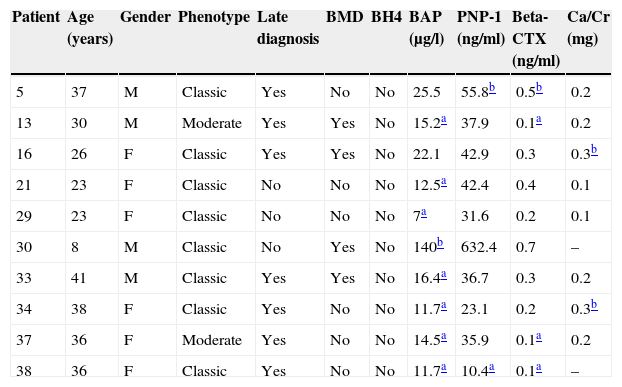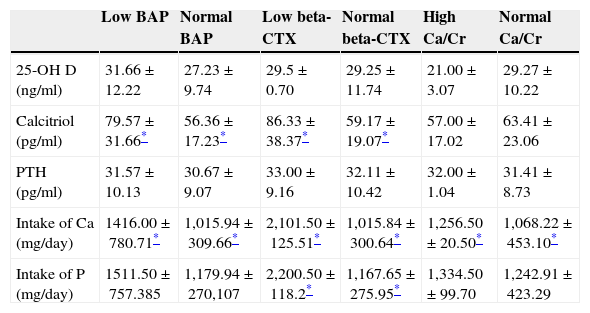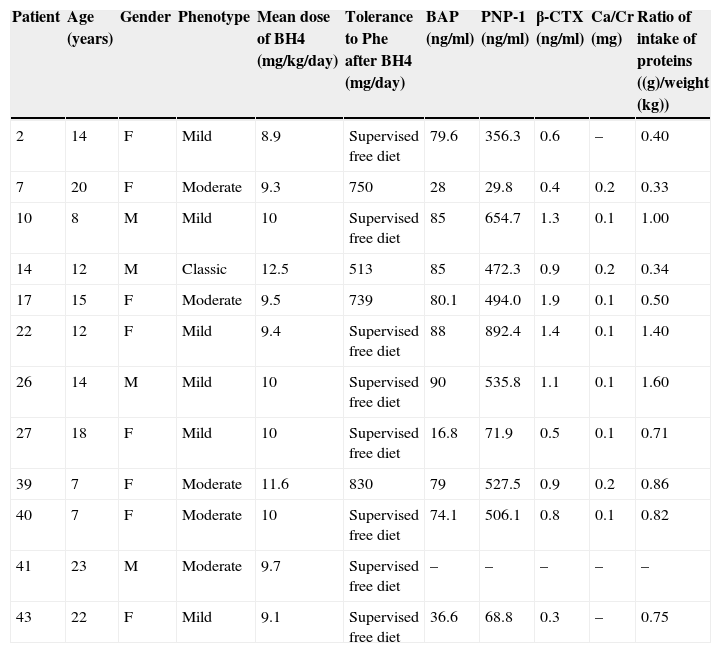Mineral bone disease is more common in phenylketonuric patients. The objectives of this study were to determine the usefulness of biochemical bone markers to identify phenylketonuric patients with mineral bone disease (MBD) and know the underlying bone remodelling alterations.
Patients and methodCross-sectional study of 43 phenylketonuric patients >7 years (range 7.1–41 years). A nutritional survey was performed and bone alkaline phosphatase (BAP), procollagen type 1 N-terminal propeptide (PNP-1), beta-crosslaps and ratio calcium/creatinine in urine were determined.
ResultsA percentage of 20.9 of patients had pathological biochemical bone markers, 90% of them being adults. BAP was decreased in 70% of them and beta-crosslaps in 42.8%. BAP values were more often pathological in phenylketonuric patients with a late diagnosis (41.7 vs. 10.7%; p<.05) and in patients with MBD (60 vs. 14.3%; P<.05). PNP-1 values and calcium/creatinine were similar among all phenylketonuric patients regardless of presenting MBD, late diagnosis or tetrahydrobipterin treatment (enzyme cofactor). Patients with decreased BAP and beta-crosslaps had lower natural protein intake: BAP (0.21±0.13 vs. 0.65±0.65g/kg; p<.05); beta-crosslaps (0.29±0.23 vs. 0.65±0.66g/kg; p<.05). None of the tetrahydrobiopterin treated patients showed altered values of BAP, PNP-1 or calcium/creatinine.
ConclusionsAdult phenylketonuric patients with lower natural protein intake tend to have lower values of BAP, which is a marker that may be useful to identify patients at risk for MBD.
La enfermedad mineral ósea (EMO) es más frecuente en pacientes con fenilcetonuria. Los objetivos del estudio son conocer la utilidad de los marcadores de remodelado óseo para identificar a pacientes con fenilcetonuria con EMO y conocer las alteraciones del remodelado óseo subyacentes.
Pacientes y métodoEstudio observacional transversal de 43 pacientes con fenilcetonuria>7 años (extremos 7,1-41 años). Se realizó encuesta nutricional, densitometría, determinación de fosfatasa alcalina ósea (FAO), procollagen type 1 N-terminal propeptide (PNP-1, «propéptido aminoterminal del procolágeno tipo 1»), beta-crosslaps y relación calcio/creatinina en orina. Se estratificó a los pacientes por edad y tipo de tratamiento.
ResultadosEl 20,9% de los pacientes presentaron marcadores de remodelado óseo patológicos; el 90% de ellos eran adultos. La FAO estaba disminuida en el 70% de ellos, y el beta-crosslaps en el 42,8%. Los valores de FAO fueron patológicos con más frecuencia en diagnosticados de fenilcetonuria tardíamente (41,7 frente a 10,7%; p<0,05) y en pacientes con EMO (60 frente a 14,3%; p<0,05). Los valores de PNP-1 y calcio/creatinina fueron similares entre todos los pacientes con fenilcetonuria independientemente de presentar EMO, diagnóstico tardío o tratamiento con tetrahidrobiopterina. Los pacientes con disminución de FAO y beta-crosslaps recibieron menor ingesta de proteínas naturales: FAO (media [DE] de 0,21 [0,13] frente a 0,65 [0,65] g/kg; p<0,05); beta-crosslaps (media de 0,29 [0,23] frente a 0,65 [0,66] g/kg; p<0,05). Ninguno de los tratados con tetrahidrobiopterina presentó valores alterados de marcadores óseos.
ConclusionesLos pacientes adultos fenilcetonúricos con menor ingesta de proteínas naturales tienden a presentar valores disminuidos de FAO, marcador que puede resultar útil para identificar a los pacientes con riesgo de presentar EMO.









